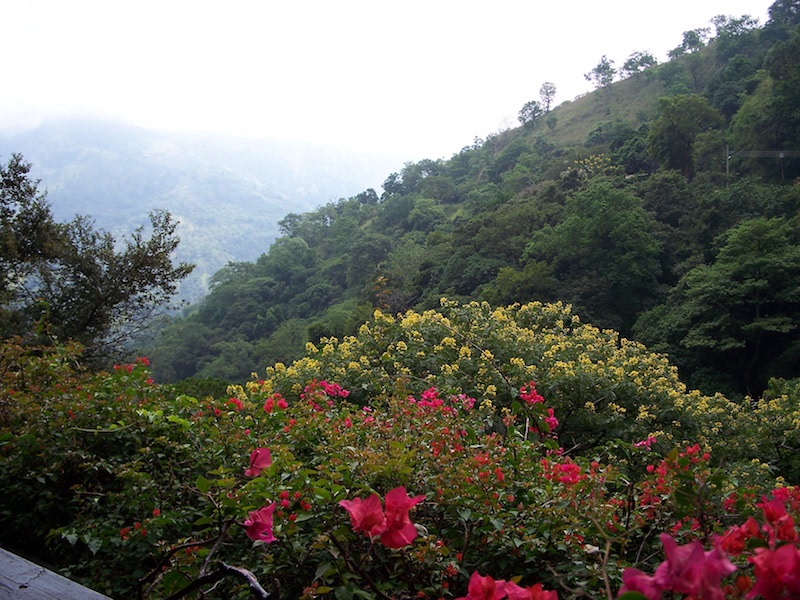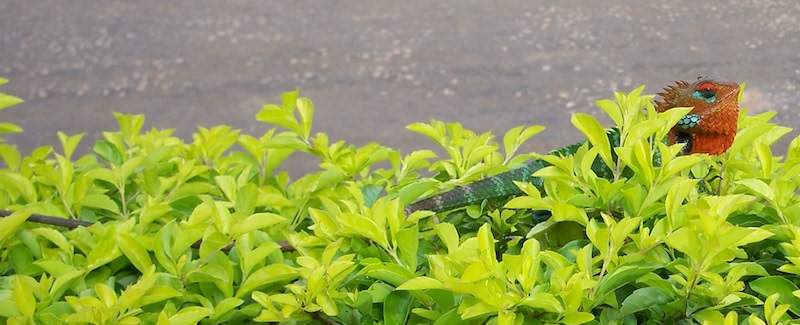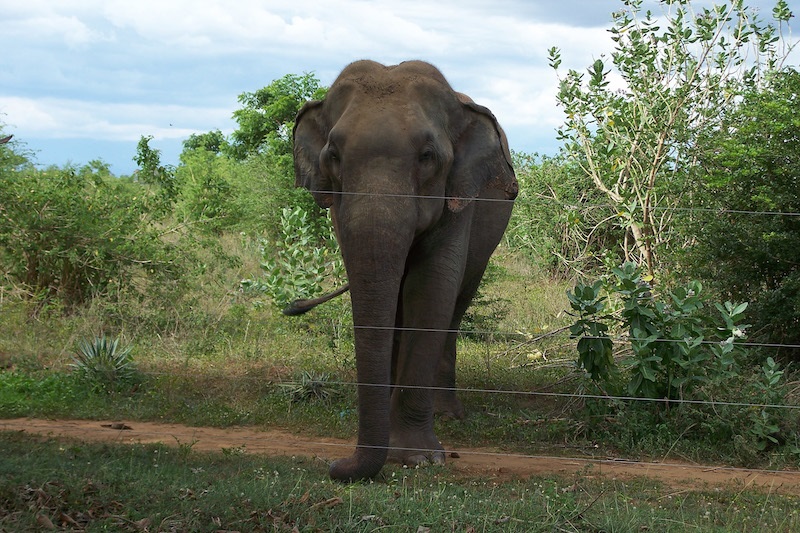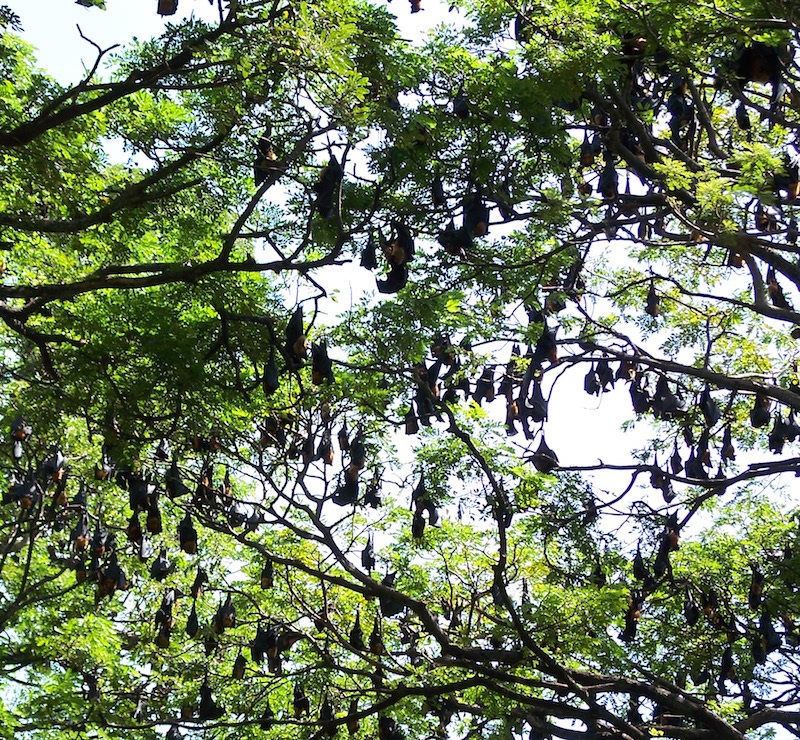Sri Lanka is a continental island of the Indian subcontinent, shaped like a teardrop falling from the southern end of India, situated between longitudes 79º 39E and 81º 53E and latitudes 5º 54N and 9º 52N. It’s 437km long from north to south and only 225km at its widest. Its area of 66,000sq km is about the same size as Ireland. The south-central region is mountainous and has an elevation ranging from 900m to 2440m. This is surrounded by an upland belt of 300-900m elevation. The coastal plains hardly exceed 100m in elevation. This plain is most extensive in the north and east, and the continental shelf ends fairly close to the shoreline except in the northwest where it is continuous with that of India. Today Sri Lanka is considered one of the most bio-diverse areas in South Asia. Recent scientific evidence indicates that many of the plants species in the southwest of the country have a Deccan-Gondwana ancestry.
The drainage pattern of the country is almost entirely governed by the central highlands, with all the perennial watercourses originating in the mountains and winding their way down to the plains below.
Climate
Sri Lanka’s equatorial position gives its lowlands a tropical climate, with year round temperatures of 27-28ºC and a relatively constant day length. It is always the right season somewhere on the island Rainfall is largely governed by monsoonal winds, which occur during two seasons of the year. From mid-May to September, the monsoon blows from the southwest direction and brings in a greater amount of moisture than during December to February when the wind blows from the northeast. The distinct inter-monsoonal periods receive convectional rains at times cyclones. During the southwest monsoon, the position and dramatic relief of the southwestern side of the central highlands forces the moisture-laden air upwards. The rapidly cooled air condenses, causing precipitation mostly on the windward slopes of the island’s southwest. During this time the northeastern and southeastern parts of the island hardly get any rain. On the other hand, the northeast monsoon winds rise over the central highlands more gradually, and the rain shadow effect is not nearly so distinct, allowing precipitation to fall on the entire island. This has resulted in the division of the country in to two major climatic zones; the wet zone, which receives rain from both monsoons, and the dry zone, which receives rain from only one. The gradual change from the wet zone to dry zone allows an intermediate zone to exist. In addition, two small areas at the extreme northwest and southeast of the country have a very dry climate and known as arid zones.

Vegetation types
Vegetation reflects the combined effect of topography, climate and soils. In Sri Lanka the natural vegetation is predominated by a diversity of forest types. Only a small fraction of land is under non-tree-dominated vegetation. This is mainly grassland, and coastal and fresh water wetlands.
The most extensive type of forest in the island is the dry mixed evergreen forest found in the dry zone (also called semi-evergreen forests). In the intermediate zone, the vegetation gradually changes to moist semi-evergreen forests. Although these forests have a fair proportion of deciduous species, they are essentially evergreen. In the wet zone vegetation has been largely categorised by elevation with wet-evergreen forests orrain forests in the lowlands and hills, lower montane forests on the lower slopes of mountains between 1,000m and 1,500m, and montane forests above 1500m. Also in the coastal areas mangroves and salt marshes colonise inundated bays while areas inundated by fresh water have swamp and floodplain forests.
Within each climatic zone, the presence and extent of specific habitat types determine the occurrence and prevalence of particular species of birds. Within dry zone, for example, habitats such as forests, marshes, grassland, man-made lakes, coastal mudflats etc. harbour certain species of birds, which are restricted to that specific habitat or are most often associated with it. While some species of birds occur in both zones at all elevations (e.g. Junglefowl) the distribution of many others is more limited. Many species and subspecies of birds are endemic to Sri Lanka and a significant number of these are more or less restricted to and characteristic of the rain forests of the wet zone. Some of this wet zone endemics are further restricted to the higher hills.
Avifauna of Sri Lanka
Sri Lanka has a total list of over 430 species of birds. Of these, 233 are resident and these include the most important 26 species that are recognised as endemic to the country. Most of the resident species are shared with the Asian mainland. A further 198 species have been recorded as migrants to the country. The majority of these migrate to Sri Lanka during the northern winter and are present from about August/September to April/May. In contrast, pelagic species of seabirds like Shearwaters, Petrels, Storm-Petrels etc migrate to Sri Lankan waters from southern oceanic islands during the southern hemisphere`s winter. Of the migrants, about 100 species regularly visit the country. The rest are occasional visitors and vagrants.
Other Wildlife
While many people go to Sri Lanka for its special birds there is plenty of interest to the more generalist nature lover. One cannot help but notice the many large and colourful butterflies for example and be aware of its reptiles and amphibians including two species of crocodile, large turtles, many snakes and lizards.

It still has some wonderful mammals too. One of the scarcer is the dugong confined to marine wetlands and estuaries. Elephants are still a common site but apart from the domesticated ones there is still a healthy wild population preserved particularly in the national parks.

There are two loris species and several monkeys, the commonest being macaque but also Purple-faced and Tufted Grey Langur. There are porcupines and many other rodents including a number of squirrels. Unfortunately the amazing Pangolin is becoming less and less common. Otters, mongooses and jackals are still to be seen and a number of the smaller wild cat species and leopard is holding on too. There are a number of deer species, will boar and the very uncommon sloth bear. Perhaps the most widely spread and easiest to see are the many species of bats including some large flying foxes.

When to go
Any period between October to late April or early May is best for visiting birders. This period is best because all the winter visitors to the country are present and there is a very good chance of seeing a load of wintering waders and some spectacular migrants such as Indian Pitta, Pied Thrush, Kashmir Flycatcher, Orange-headed Thrush etc. If the visitor is not so much interested in the migrants, May, June and July are also good time to arrive in the island.
Wildlife sites
There are many good birding sites but Sinharaja World Heritage Wilderness area, Bundala Ramsar site, Yala and Uda Walawe National Parks; Horton Plains are imperative for any birder. These will give all the endemics plus some other spectacular species. A 12 to 14 day tour of the island will give about 225 species, if the visitor is with the right person who knows his birdcalls and the places to go.
Bundala National Park (Map)
This NP is a Ramsar Site and is situated in the dry zone and borders the Indian Ocean. This comprises of dry semi-evergreen forest, scrub jungle and shallow water holes. The beaches in this are important sites for nesting Turtles.
Birds likely to be seen:
Little Grebe, Little Cormorant, Indian Shag, Great Cormorant, Indian Darter, Spot-billed Pelican, Night Heron, Little Green Heron, Indian Pond Heron, Cattle Egret, Little Egret, Median Egret, Large Egret, Grey Heron, Purple Heron, Painted Stork, Openbill, White-necked Stork, White Ibis, Spoonbill, Greater Flamingo, Brahminy Kite, White-bellied Sea Eagle, Crested Serpent Eagle, Crested Hawk-Eagle, Little Pratincole, Little Ringed Plover, Ringed Plover, Kentish Plover, Lesser Sand Plover, Large Sand Plover, Golden Plover, Grey Plover, Yellow-wattled Lapwing, Red-wattled Lapwing, Little Stint, Curlew Sandpiper, Ruff, Pintail Snipe, Black-tailed Godwit, Common Redshank, Marsh Sandpiper, Common Greenshank, Green Sandpiper, Wood Sandpiper, Common Sandpiper, Turnstone, Brown-headed Gull, Gull-billed Tern, Caspian Tern , Large-Crested Tern, Lesser-Crested Tern, Little Tern, Saunders’s Tern, Whiskered Tern, White-winged Black Tern
Horton Plains National Park (Map) A highland plateau comprising of montane forest and grassland. Famous among the birders for the highland endemics like the Dull-blue Flycatcher, SL Wood Pigeon, Bush Warbler, Yellow-eared Bulbul and the most elusive crepuscular Whistling Thrush also called Arrenga. Other birds of interest are the Pied Bush Chat, Grey Tit, Grey-headed Canary Flycatcher, Spot-winged Thrush and SL Scimitar Babbler.
Sinharaja Forest Reserve (Map)
Sinharaja Biosphere Reserve, which was declared a World Heritage site in 1988, is arguably the best site in Sri Lanka for birds as it harbours 21 out of the 26 endemics. This reserve contains some of the few remaining sizeable tracts of undisturbed lowland rain forest. Much of the bird watching is done in the area where once selective logging was carried out. Be prepared for leeches in this forest. It is also a good site for Langur
Birds likely to be seen:
Sri Lanka Spurfowl, Sri Lanka Junglefowl, Sri Lanka Wood Pigeon, Sri Lanka Hanging Parrot, Layard’s Parakeet, Red-faced Malkoha, Green-billed Coucal, Chestnut-backed Owlet, Sri Lanka Grey Hornbill, Yellow-fronted Barbet, Crimson-fronted Barbet (Ceylon Small Barbet); Black-crested Bulbul (Black-capped Bulbul); Spot-winged Thrush, Brown-capped Babbler, Orange-billed Babbler (Ceylon Rufous Babbler); Ashy-headed Laughing-Thrush, Legge’s Flowerpecker, Sri Lanka White-eye (Ceylon Hill White-eye); Sri Lanka Blue Magpie, White-faced Starling Sturnus senex, Sri Lanka Myna (Ceylon Hill-Myna); Black-throated Munia. (Ceylon Hill Munia); Malabar Trogon, Black Bulbul, Dark-fronted Babbler, SL Scimitar Babbler, Greater Raquet-tailed Drongo, Green Imperial Pigeon, Ceylon Frogmouth, Crested Honey Buzzard, Crested Serpent Eagle, Crested Goshawk, Shikra, Black Eagle, Rufous-bellied Hawk-Eagle, Mountain Hawk-Eagle.
Uda Walawe National Park (Map)
This is another dry zone area which is the catchment of a very large man made reservoir. A mixture of abandoned Teak plantation, grassland, scrub jungle and some riverine forests. This is a great site for birds but is also a very famous site for Elephants.
Text Source: Fatbirder
Photo Source: ©Bo Beolens Fatbirder
Map Source: Googlemaps™
